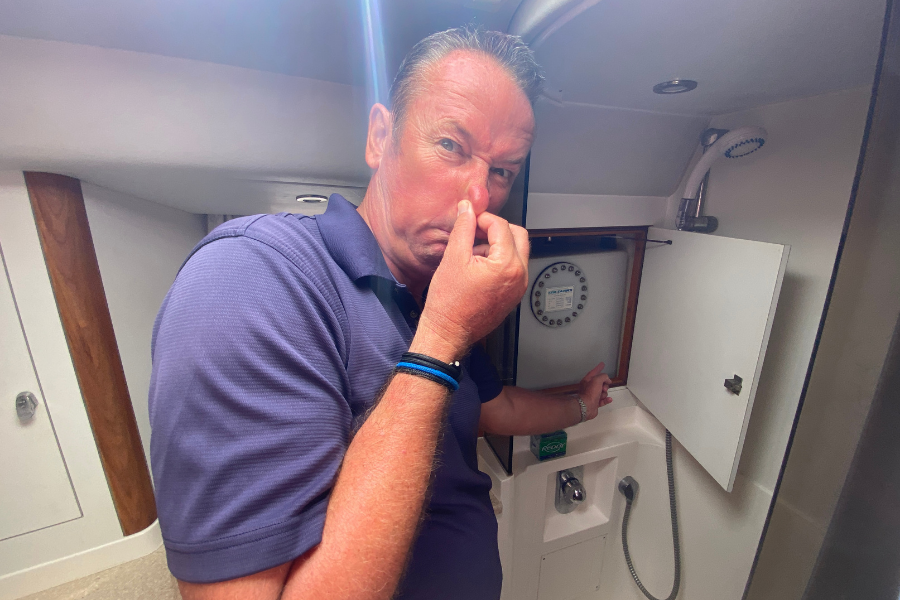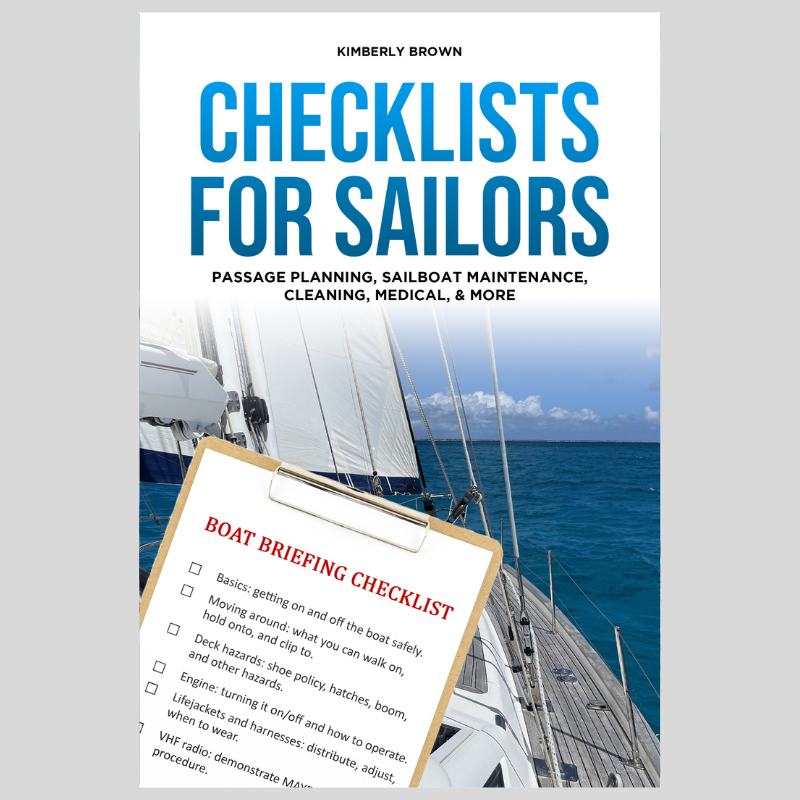No one wants a boat that smells like crap. Here’s how to prevent and eliminate boat toilet stink for good!
Are you one of those boat owners with a smelly head or heads? Have you tried everything, but the heads still stink? Cleaning and servicing your head is usually a job done in anger. It’s due to blockages or bad smells, but it doesn’t have to be this way.
It might sound too easy to be true, but I will share with you three secrets that will revolutionize how you look after your heads. Watch this video on preventing and eliminating boat toilet stink, and your boating lifestyle will be far more enjoyable.
Prevent And Eliminate Boat Toilet Stink Video
Three Secrets To Prevent And Eliminate Boat Toilet Stink
So, the first secret is that you have to flush your toilet way longer than you think necessary.
Whether you have an automatic toilet or the pump version, you’ll want to flush it long enough to get the urine into the tank. When urine and saltwater mix, it forms concrete, as shown in the video.
I know this is difficult to calculate if you’re pumping into a tank. Surely you don’t want to use too much space. But the key is to flush it enough so that all the urine enters the tank rather than sitting in the line.
This is important because by spending an extra minute flushing your heads, you’ll save yourself hours, if not days, of work cleaning or swapping out blackwater lines.
The second secret is routinely using vinegar and diluted muriatic acid to flush the lines monthly. I use vinegar every month in all our black and gray water lines. And then, every quarter, I’ll do a diluted muriatic flush.
The main thing to understand here is that flushing long enough will get a lot of grime out. But what’s left over, the vinegar and muriatic acid, will definitely eliminate. This means you will not get blockages due to build-up.
You’ll also drastically reduce the likelihood of bad smells.
The third secret is to clean your black water tank at least every year or twice a year. The main thing to understand here is that the tanks get gunked up over time. If you don’t flush them with some fresh water and clean them, they’ll smell.
Get Your Checklists for Sailors Guide
This cleaning routine for our heads is part of a more comprehensive list that you will find in our Checklists For Sailors guide. If you’re interested in having ready-made checklists on what to clean and when to clean it for all your boat cleaning jobs (on deck, below deck, etc.) in addition to checklists for passage planning, what to do before/during/after a journey, engine servicing, medical situations and more, get a copy of our guide.
Here’s one of our hundreds of reviews.
Simon Getting Close To The Black Water Tank!

Other Articles Aside From How To Prevent And Eliminate Boat Toilet Stink
- How To Prevent Boat Fails
- How You Can Easily Create Sailing Checklists (To Prevent Boat Failures)
- Top 10 – The Reality Of Boat life
- How To Clean A Boat Water Tank
Any Questions?
Please Leave Them Below.

Hi guys , hope all well and enjoying your “escape” we didn’t manage our planned UK circumnav this year on our Oyster 47 Aequitas , but we did do 1200 “round the top” miles from Inverness including Orkney’s , cape Wrath and lots of Scottish west coast islands over 3 months . Our take on toilet smells is to flush with just fresh water, and we don’t seem to get any “pongs” I believe it’s the salts in pee reacting with the sodium chloride and other organics in salt water that makes small amounts of hydrogen sulphide “ bad eggs” fresh water doesn’t have The salts or organics in it hence no smell generated , try it for a few days and see …
realise it’s using fresh water when that has to be “made” but does seem to work .
Hey Paul, I totally agree with you. When we’re in an area with really dirty salt water, we fill the tank with our shower hose and just flush that out rather than brining in the salt water. Just doing that for a few days seems to help quite a bit. Sounds like your 1200 was awesome. We’ve always talked about doing that… I fear I’m too spoiled by the warm tropic weather now – not sure I can do cold anymore. Hahahaha. Thanks for commenting. Kim
Hi Simon,
I have also researched the stinky head issue and after many hours of research I found the real problem is not in the exit waste water but the stagnant water trapped in the inlet hose from the seacock to the toilet. The water is trapped and has a reaction as the enzymes die and you get stagnant water while the bacteria rots and causes the rotten egg smell.
So its the delivery side that is the problem i find. Poor choice of industrial toilet hose is also an issue allowIng more bacteria to form.
Great feedback David… very good points. I think that bad smells can come from any part of the black water process 🙁 Thanks for commenting! Simon
Hi Simon
Thanks for the info… did you find a fix for this issue? Cheers
thank you for the info; this will prep us ahead of time before buying our boat.
again thank you very much.
safe sailing…
If the length of time for flushing is the problem then perhaps all boats should be fitted with a variable timer to ensure everybody correctly flushes.
No kidding! Or a ‘normal’ flusher. Brian…the marine world is behind the times! Smiles, Kim
I installed a SeaSmart sanitiser which injects a small amount of antibacterial stuff just before the sea water inlet seacock and it works really well. The typical boat heads smell is actually of dead seawater microbes stuck to the inlet pipe, nothing to do with the black water leaving the bowl either to the tank or when you empty it. This product eradicates that smell which is definitely worth paying for.
Great feedback Mike. After we changed our black water pipes our smell disappeared so there might be something to that too… I’ve found that anything to do with a boat is never black and white. Thanks for commenting 🙂 Kim
Peggie Hall (aka The Headmistress) has written a phenomenal book called “Get Rid of Boat Odors”. On her advice I bought Zaal’s NoFlex Digestor and it does an amazing job on stinky holding tanks. You can order it on line (I ordered through Marine Sanitation) – have yet to find it in a marine store though I have asked West Marine to carry it. Not expensive either. Highly recommend the product and Peggie’s book. She just came out with a second edition.
Great recommendation Melanie! I will get it myself 🙂 Kim
How much muriatic acid/water do you use at one time? I know you said 1:10 ratio – but should I use
1 cup acid to 10 cups water? Or, 1 gallong muriatic acid to 10 gallons water?
Our holding tank is 20 gallons.
Simon does 1:5 to 1:10…He starts with 3-4 cups of Muriatic Acid. Smiles, Kim
Hi
Does he mix the acid with the water before pouring in the toilet?
I just want to be sure so we don’t ruin anything! Thank you.
Yes Terry – mix it 10 to 1 and start with that. Smiles, Kim
This may be a bit late, but there is an absolute, sure fire solution to the issue of smelly heads, and to a degree, I think, calcium build up. It is simplicity itself.
Most of us have a sink/basin by the heads. All that is needed is a shut-off valve in the sink discharge pipe, and just above it an unequal tee, with a pipe the same diameter as the heads inlet, which is connected to the heads inlet hose, preferably just above the heads inlet seacock.
We all know that whilst on the boat, and once the original smell has cleared, the bog doesn’t smell. It is mostly when we join the boat after a while that it is so noticeable. this is because all the nasty chemical reactions have been going on in our absence. If we remove one of the components, salt water, and replace it with fresh, these reactions cannot take place.
The routine is, as part of the procedure for leaving the boat, to shut off the heads inlet seacock, and close the sink discharge valve. Fill the bowl full of fresh water (it can’t drain away now) and pump it through the system. On rejoining the boat, do the reverse.
Great idea Peter. Thank you for sharing! 🙂